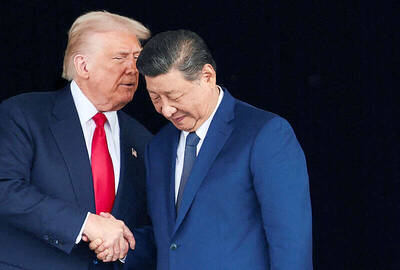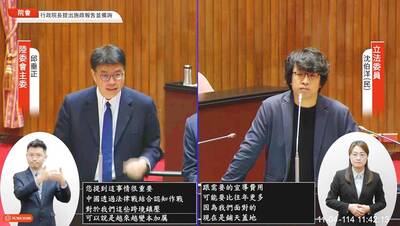Japan is sending 100 soldiers and radar equipment to its westernmost outpost, a tropical island off Taiwan, in a deployment that risks angering China with ties between Asia’s biggest economies already hurt by a dispute over nearby islands they both claim.
Japanese Minister of Defense Itsunori Onodera is to break ground today for a military lookout station on Yonaguni, which is home to 1,500 people and just 150km from disputed Japanese-held islands claimed by Taiwan and China.
The mini-militarization of Yonaguni — now defended by two police officers — is part of a longstanding plan to improve defense and surveillance in Japan’s far-flung frontier.
Building the radar base on the island, which is much closer to China than to Japan’s main islands, could extend Japanese monitoring to the Chinese mainland, and track Chinese ships and aircraft circling the disputed crags, called the Senkakus by Japan and the Diaoyutais (釣魚台) by Taiwan.
“We decided to deploy a Ground Self-Defense Force unit on Yonaguni Island as a part of our effort to strengthen the surveillance over the southwestern region,” Onodera said this week. “We are staunchly determined to protect Yonaguni Island, a part of the precious Japanese territory.”
The 30km2 backwater — known for strong rice liquor, cattle, sugarcane and scuba diving — may seem an unlikely place for Japanese Prime Minister Shinzo Abe to put boots on the ground.
However, Yonaguni marks the confluence of the Japanese defense establishment’s concerns about the vulnerability of the country’s thousands of islands and the perceived threat from China.
The new base “should give Japan the ability to expand surveillance to near the Chinese mainland,” said Heigo Sato, a professor at Takushoku University and a former researcher at the defense ministry’s National Institute for Defense Studies.
“It will allow early warning of missiles and supplement the monitoring of Chinese military movements,” Sato said.
Japan does not specify an enemy when discussing its strategy to defend its remote islands, but it makes no secret that it perceives China generally as a threat — a giant flexing its growing muscle and becoming an Asian military power to rival Japan’s ally, the US, in the region.
Japan, in National Defense Program Guidelines issued in December, expressed “great concern” over China’s rapid military buildup, opaque security goals, its “attempts to change the status quo by coercion” in the sea and air, and such “dangerous activities” as last year’s announcement of an air-defense identification zone.
Japan’s remote-island strategy, set out in the guidelines, is to “intercept and defeat any invasion by securing maritime supremacy and air superiority” with swift deployments supplementing troops positioned in advance.
“Should any remote islands be invaded, Japan will recapture them. In doing so, any ballistic missile or cruise missile attacks will be dealt with appropriately,” the guidelines say.
Yonaguni, at the western tip of Japan’s 3,300km southwestern island chain, is practically within sight of the disputed rocks that are the feared flashpoint of Japan’s island strategy, which could draw the US into a fight.
Onodera’s groundbreaking ceremony comes four days before US President Barack Obama lands in Tokyo for a summit with Abe, the first state visit by a US president in 18 years.
Japanese and Chinese navy and coast guard ships have played high-stakes cat and mouse around the disputed islets since Japan nationalized the formerly privately owned territory in September 2012. Japanese fighter jets scrambled against Chinese planes a record 415 times in the year through last month, up 36 percent from the previous year, the Japanese Ministry of Defense said last week.
Tapping such concerns, Abe raised military spending last fiscal year for the first time in 11 years.
He is bolstering Japan’s capability to fight for islands with a new marine unit, more longer-range aircraft, amphibious assault vehicles and helicopter carriers. Although the country’s landmass is smaller than California, its thousands of islands give it nearly 30,000km of coastline to defend.
However, tight fiscal constraints mean Japan cannot keep pace with China’s yearly double-digit military budget increases.
The people of Yonaguni, where Abe wants to station 100 troops and perhaps as many family members within two years, have mixed feelings about their imminent role in facing off against China.
“Opinion is split down the middle,” Tetsuo Funamichi, the head of the island’s branch of the Japan Agricultural Association, said by telephone. “It’s good for the economy if they come, but some people worry that we could be attacked in an emergency.”
Takenori Komine, who works in an island government office, said it was a risk worth taking if it meant reviving an outpost of Japan that has been in decline since a brief postwar boom.
At that time, US-occupied Yonaguni’s proximity to Taiwan made it an entry point into Japan for smuggled food and clothing from Hong Kong. Since the end of World War II, the island’s population has withered by about 90 percent. Average income of about US$22,500 a year is a fifth below the national average.
“We are hopeful that the arrival of the young troops will bolster local consumption,” Komine said.
However, Yonaguni’s mainstays — beef and sugarcane — are in the crosshairs of trade negotiations. Abe is trying to defend Japan’s high tariffs on them, but has recently agreed to beef tariff cuts for Australia and is under strong pressure to do the same for the US before Obama’s visit, as part of broad talks on an ambitious Trans-Pacific Partnership (TPP) trade pact.
“If the TPP includes sugar, this island is finished,” Funamichi said.
And a sharply falling population on Yonaguni would have security implications, a government official said.
“It’s not good from the perspective of securing our territory,” the official in Tokyo said. “If people don’t live there, you could lose your claim to effective control.”

CALL FOR SUPPORT: President William Lai called on lawmakers across party lines to ensure the livelihood of Taiwanese and that national security is protected President William Lai (賴清德) yesterday called for bipartisan support for Taiwan’s investment in self-defense capabilities at the christening and launch of two coast guard vessels at CSBC Corp, Taiwan’s (台灣國際造船) shipyard in Kaohsiung. The Taipei (台北) is the fourth and final ship of the Chiayi-class offshore patrol vessels, and the Siraya (西拉雅) is the Coast Guard Administration’s (CGA) first-ever ocean patrol vessel, the government said. The Taipei is the fourth and final ship of the Chiayi-class offshore patrol vessels with a displacement of about 4,000 tonnes, Lai said. This ship class was ordered as a result of former president Tsai Ing-wen’s (蔡英文) 2018

‘SECRETS’: While saying China would not attack during his presidency, Donald Trump declined to say how Washington would respond if Beijing were to take military action US President Donald Trump said that China would not take military action against Taiwan while he is president, as the Chinese leaders “know the consequences.” Trump made the statement during an interview on CBS’ 60 Minutes program that aired on Sunday, a few days after his meeting with Chinese President Xi Jinping (習近平) in South Korea. “He [Xi] has openly said, and his people have openly said at meetings, ‘we would never do anything while President Trump is president,’ because they know the consequences,” Trump said in the interview. However, he repeatedly declined to say exactly how Washington would respond in

WARFARE: All sectors of society should recognize, unite, and collectively resist and condemn Beijing’s cross-border suppression, MAC Minister Chiu Chui-cheng said The number of Taiwanese detained because of legal affairs by Chinese authorities has tripled this year, as Beijing intensified its intimidation and division of Taiwanese by combining lawfare and cognitive warfare, the Mainland Affairs Council (MAC) said yesterday. MAC Minister Chiu Chui-cheng (邱垂正) made the statement in response to questions by Democratic Progressive Party (DPP) Legislator Puma Shen (沈柏洋) about the government’s response to counter Chinese public opinion warfare, lawfare and psychological warfare. Shen said he is also being investigated by China for promoting “Taiwanese independence.” He was referring to a report published on Tuesday last week by China’s state-run Xinhua news agency,

‘ADDITIONAL CONDITION’: Taiwan will work with like-minded countries to protect its right to participate in next year’s meeting, the foreign ministry said The US will “continue to press China for security arrangements and protocols that safeguard all participants when attending APEC meetings in China,” a US Department of State spokesperson said yesterday, after Beijing suggested that members must adhere to its “one China principle” to participate. “The United States insists on the full and equal participation of all APEC member economies — including Taiwan — consistent with APEC’s guidelines, rules and established practice, as affirmed by China in its offer to host in 2026,” the unnamed spokesperson said in response to media queries about China putting a “one China” principle condition on Taiwan’s